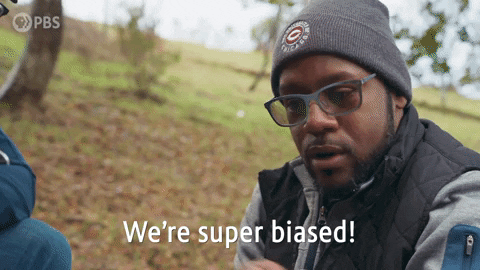Well, a lot. But before we get to that, what does AI mean?
AI is a machine’s ability to process information. Machine learning is the process of training an AI machine.
HOW DOES IT WORK?
“Both humans and AI essentially interpret data based on what they have learned from experience,” says Dr Naveed Akhtar, a senior lecturer of machine learning, AI and data science at the University of Western Australia.
Naveed is also a Senior Research Fellow with the Australian Office of National Intelligence.
According to him, humans and AI can learn in a similar way. But there are key differences.

GIPHY
Humans have evolved to be ‘adaptive’ thinkers. We can use emotions and other sensory experiences to quickly adapt and navigate unforeseen circumstances. In contrast, AI is built to deal with a specific task using previously collected data.
“In the case of humans, we normally have a lot of experience with a wide variety of aspects of our daily life,” says Naveed.
“An AI system generally lacks this kind of experience.”
GETTING SCHOOLED IN AI
ChatGPT is currently one of the best-known AI technologies. It’s a language processing tool (or chatbot) that you can have human-like conversations with.
You can ask it questions or prompt it to generate text – like writing that pesky essay for you.
“We’re already adapting to ChatGPT in academia,” says Naveed.
Some WA schools are banning ChatGPT. And tertiary institutions such as UWA are returning to pen-and-paper exams to avoid cheating via ChatGPT.
WHERE’S MY AI?
Big businesses develop custom AI to optimise their operations.
The Southern Ports Authority uses AI software to identify and fix machines before they break down.
Data about temperature, vibration and noise is fed to machine learning AI software. And the software detects problems before they cause machine failure.
“We’re experiencing an increase in number of startups in WA that are materialising from the recent breakthroughs in AI,” says Naveed.
Small businesses already have access to a variety of AI tools. They’re mostly used to perform repetitive tasks like transcribing interviews and formatting documents. However, they can also provide interactive customer service.
“AI is normally best applied to the tasks for which we can easily produce large amount of training data, and the task by itself is of repetitive nature,” says Naveed.
One popular example is ChatGPT, a model that was trained on language used across the internet. The model learned to use language based on statistical patterns in words. Now it can write sentences and conversations based on prompts.
“AI is excellent in … manufacturing, supply chain management and even in customer services to free up some human resources for more complex and creative tasks.”
WILL AI REPLACE ME?
Modelling by Cisco predicts upcoming technology could replace around 630,000 Australian workers by 2028.
Business and professional services (jobs like accounting and marketing) are tipped to be the most affected – losing 100,000 jobs.
On the flip side, the report says 280,000 new jobs will be created in healthcare, wholesale retail and professional services by 2029.

GIPHY
RUN IT BIAS FIRST
Many of the risks associated with AI stem from the people operating them.
We feed the raw data to the machine. So our biases can be built into the decisions an AI machine learns to make.

GIPHY
“The responsible use of AI demands that we can identify a human operator that can be held accountable if the AI system misbehaves,” says Naveed.
It’s difficult to check how an AI machine makes decisions. If a person trains a biased machine, the fault can be invisible until it’s too late.
SHOULD WE BE WORRIED?
In 2018, Amazon used an AI recruitment tool to rank job candidates. They scrapped it because it discriminated against women.
Survival of the Best Fit is a free educational game about hiring bias in AI. It aims to explain how the misuse of AI can lead to inequality.
“[Ethically] AI systems … lack empathy, emotions and genuine creativity,” says Naveed.
“For the decisions or tasks in which these aspects become critical, we should not rely only on AI.”
There are also security concerns about the use of AI – particularly around private and potentially sensitive information.
The Royal Australian College of General Practitioners warns doctors against using ChatGPT for patient notes.
Five Perth hospitals have banned staff from using ChatGPT because of patient confidentiality concerns.
NATURAL INTELLIGENCE
AI has advanced at an unprecedented rate over the past few decades.
It represents change – with benefits as well as risks.
While AI can help us and may replace some of our jobs, it can’t be us.
A machine is yet to copy our individual creativity, sense of empathy or understanding.









